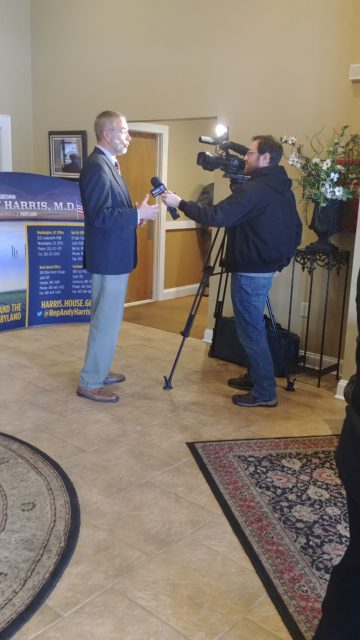Back with bloggy goodness in bite-sized chunks of a couple sentences to a few paragraphs. Let’s see what the e-mail bag has in store.
A pro-life concern
Political e-mail is often chock full of hyperbole, but I found a recent e-mail from the folks at the Maryland Pro-Life Alliance PAC interesting – is there really a renewed pro-abortion push here? They call it a “political attack group,” a 501 (c)(4) which “will be able to take massive checks from outside Maryland starting from Day 1.” But I didn’t find any news story on the subject, which makes it sound like just so much hype.
To me, theirs is the kind of e-mail that sets back the cause. Don’t just tell me there’s an AP story, give me a link – for all I know this was three years ago. It’s bad enough that a group with less than $1,000 in the bank, and a group that didn’t spend a dime on candidates in the 2018 election, is asking for money to counter this phantom threat.
More bad news for Maryland business
The headline of a Maryland Public Policy Institute business climate study made it sound like businesses are becoming less optimistic about business conditions in the state overall, yet they remain relatively positive.
But buried in the remaining information was an interesting dichotomy between businesses along the I-95 corridor, where companies believing the state was business-friendly prevailed by a 49-16 average margin, and outstate companies which only deemed the state business-friendly by a 39-35 count. Given that the overall mark was 46-19, it’s apparent that the outstate entities were but a small portion of the survey – probably no more than 15%. However, that’s 100% of the issue here on Delmarva.
Add to this the war on plastic – which is in the process of having the good guys lose in Delaware – as well as the laughable job creation numbers proponents of the maglev boondoggle are touting, and we may have seen an economic peak on Delmarva until people with real sanity are placed back in government, at least in the view of the MPPI.
But their annual magnum opus is the Annapolis Report, which grades the Maryland General Assembly on its work for the session. If they were a college student, the MGA would be on academic probation.
The Democrats’ deplorable problem
For decades the prevailing belief was that Republicans were for the business man while Democrats were for the working man. In 2016, however, that philosophy was turned on its head as thousands and thousands of union workers ignored their Big Labor bosses who backed Hillary Clinton and pulled the lever for Donald Trump, enabling him to win in Wisconsin, Michigan, Ohio, and Pennsylvania.
But, as David Catron recently argued in The American Spectator, the Democrats who think those voters are the key to 2020 victory are barking up the wrong tree. He contends:
(S)upporting Trump simply isn’t the done thing in polite society. To do so is to risk loss of social status – if not outright ostracism – and open conflict with friends or family. Trump supporters mislead pollsters or simply refuse to answer their questions pursuant to similar psychological and social incentives. All of which leads to a lot of confusion concerning who it is that supports President Trump and precisely why. This, in turn, renders it very difficult for round heel politicians like Joe Biden and Elizabeth Warren to pander to “working class” voters they badly need to “win back” to the Democratic fold in the 2020 election cycle.
David Catron, “Why the Dems Will Never Win Back Trump Voters,” The American Spectator, June 24, 2019.
I’ve talked about this a couple times on the radio, and Catron makes the argument as well: I sensed this back in 2016, which is why I did “Bradley effect” updates on the Presidential race. If you believed the actual polls on a state-by-state basis, Hillary Clinton should have had upward of 300 electoral votes. But if you assume the polls underestimated Trump by five points, your blue map becomes a shade of pink that carries The Donald to victory. My last couple “Bradley effect” maps suggested a narrow Trump win so I wasn’t as shocked as I thought I might be when it really happened.
On another deplorable front, the pull of Big Labor doesn’t seem to be as strong as it used to be. I remember writing on this situation for The Patriot Post back in 2014, but even after another half-decade of trying the UAW still can’t get its hooks into an auto plant south of the Mason-Dixon line, failing again to unionize the Volkswagen plant in Chattanooga, Tennessee. This latest update comes from my friends at the Capital Research Center.
More on the Presidential sweepstakes
I have a number of different items here.
Let’s start with Erick Erickson, who points out in a brief but concise Resurgent article that Joe Biden’s not a racist – it’s just proof of how far the Democrats have moved the Overton window on that subject.
And if you want bat-crap crazy Democrats, look no further than the Indivisible crowd.
After the recent Democrat debates, the Astroturf group polled its followers and found that their preferred candidates didn’t line up with the ones on top of the mainstream polls:
We asked Indivisibles to identify which candidates they are considering voting for and which they are definitely not. The results revealed that the historic candidacies of women, people of color and LGBTQ candidates are faring well among the movement and have plenty of room to grow as the field narrows. It also revealed that some of the presumed frontrunners may hit a ceiling with activists, given how many Indivisibles say they aren’t considering them at all.
Indivisible news release, July 2, 2019.
In other words, identity politics is alive and well. “(I)f the election were held today, 35% of people said they would vote for (Elizabeth) Warren and 31% selected (Kamala) Harris,” they said. Compare this to the Morning Consult poll from yesterday (July 16) where Warren and Harris combined for just 27% of the vote, a number that still trailed frontrunner Joe Biden. In fact, those “women, people of color, and LGBTQ candidates” only account for about 40% of the vote, trailing those white males in the top 2 slots and scattered among the rest.
I’m not going to sit and do the math, but I daresay that Indivisible isn’t much of a movement when the candidates 66% of their group support can’t even muster half that amount of support in a wider poll.
Who’s really gerrymandering?
This is a fascinating study from the CRC. While the Democrats contend that independent redistricting commissions will best address the issue of gerrymandering (which, of course, only became a problem after the TEA Party wave election of 2010, which got the break of getting to draw districts for this decade), this study suggests the hype from Democrats is overblown.
Two more states – but a bunch to go
If you’re a fan of the Constitution Party, the good news is that they kept ballot access in two states (Arkansas and North Carolina) and their goal is access in 35 states. Maryland will probably not be one of them because their 10,000 signature threshold is daunting for the two minor parties which generally qualify for the ballot, the Green Party and Libertarian Party, let alone a smaller entity such as the CP. In Delaware they need over double their number of registered voters by the end of 2019 to qualify, which seems unlikely unless a concerted effort to flip members of other minor parties occurs.
And last…
You may notice this is the day of Tawes, but there’s no pictorial.
After 13 or 14 years of going, I just lost interest in the event the last few years. And considering this is a pretty much dead year on the election calendar – no 2020 Senate election and not much going on in the Congressional realm – it was not worth taking a day off to go and overpay for food, a little bit of beer, and a crapton of diet Pepsi. Since I’m not an invited guest to the tents where the real action is, I’m happier being home.
To my friends who were there, I hope you had a good time. But it just isn’t that much fun for me anymore.









